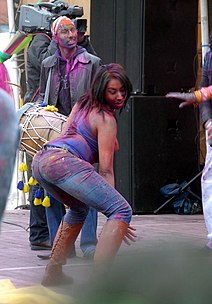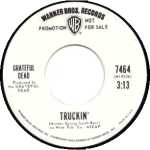Related Research Articles

The cakewalk was a dance developed from the "prize walks" held in the mid-19th century, generally at get-togethers on Black slave plantations before and after emancipation in the Southern United States. Alternative names for the original form of the dance were "chalkline-walk", and the "walk-around". It was originally a processional partner dance danced with comical formality, and may have developed as a subtle mockery of the mannered dances of white slaveholders.

Art music is music considered to be of high aesthetic value. It typically implies advanced structural and theoretical considerations or a written musical tradition. In this context, the terms "serious" or "cultivated" are frequently used to present a contrast with ordinary, everyday music. Many cultures have art music traditions; in the Western world the term typically refers to Western classical music.
In biology, a common name of a taxon or organism is a name that is based on the normal language of everyday life; and is often contrasted with the scientific name for the same organism, which is Latinized. A common name is sometimes frequently used, but that is not always the case.

Street dance is an umbrella term for a large number of social dance styles such as: breakdancing, popping, locking, house dance, waacking etc. Social dance styles have many accompanying steps and foundations, created organically from a culture, a moment in time, a way of life, influenced by natural social interaction. A street dance is a vernacular dance in an urban context. Vernacular dances are often improvisational and social in nature, encouraging interaction and contact with spectators and other dancers. These dances are a part of the vernacular culture of the geographical area that they come from.

A vernacular or vernacular language refers to the language or dialect that is spoken by people that are inhabiting a particular country or region. The vernacular is typically the native language, normally spoken informally rather than written, and seen as of lower status than more codified forms. It may vary from more prestigious speech varieties in different ways, in that the vernacular can be a distinct stylistic register, a regional dialect, a sociolect, or an independent language. Vernacular is a term for a type of speech variety, generally used to refer to a local language or dialect, as distinct from what is seen as a standard language. The vernacular is contrasted with higher-prestige forms of language, such as national, literary, liturgical or scientific idiom, or a lingua franca, used to facilitate communication across a large area.

Jitterbug is a generalized term used to describe swing dancing. It is often synonymous with the lindy hop dance but might include elements of the jive, east coast swing, collegiate shag, charleston, balboa and other swing dances.

Blues dancing is a family of historical dances that developed alongside and were danced to blues music, or the contemporary dances that are danced in that aesthetic. It has its roots in African-American dance, which itself is rooted in sub-Saharan African music traditions and the historical dances brought to the United States by European immigrants.

The black bottom is a dance which became popular during 1920s amid the Jazz Age. It was danced solo or by couples. Originating among African Americans in the rural South, the black bottom eventually spread to mainstream American culture and became a national craze in the 1920s. The dance was most famously performed by Ann Pennington, a star of the Ziegfeld Follies, who performed it in a Broadway revue staged by Ziegfeld's rival George White in 1926.

African-American dance has developed within Black American communities in everyday spaces, rather than in studios, schools or companies. These dances are usually centered on folk and social dance practice, though performance dance often supplies complementary aspects to this. Placing great value on improvisation, these dances are characterized by ongoing change and development. There are a number of notable African-American modern dance companies using African-American cultural dance as an inspiration, among these are the Whitey's Lindy Hoppers, Alvin Ailey American Dance Theater, and Dance Theatre of Harlem. Hollywood and Broadway have also provided opportunities for African-American artists to share their work and for the public to support them.

The history of Lindy Hop begins in the African American communities of Harlem, New York during the late 1920s in conjunction with swing jazz. Lindy Hop is closely related to earlier African American vernacular dances but quickly gained its own fame through dancers in films, performances, competitions, and professional dance troupes. It became especially popular in the 1930s with the upsurge of aerials. The popularity of Lindy Hop declined after World War II, and it converted to other forms of dancing, but it never disappeared during the decades between the 1940s and the 1980s until European and American dancers revived it starting from the beginning of the 1980s.

"Truckin'" is a song by the Grateful Dead, which first appeared on their 1970 album American Beauty. It was recognized by the United States Library of Congress in 1997 as a national treasure.
The slow drag is an American ragtime jazz musical form and the social dance for which the music was written. It has been resurrected as part of blues dancing. Music written for the dance is often short-handed into the song title as a "Drag"
Louis "Putney" Dandridge was an American jazz pianist and singer.

Acro dance is a style of dance that combines classical dance technique with precision acrobatic elements. It is defined by its athletic character, its unique choreography, which seamlessly blends dance and acrobatics, and its use of acrobatics in a dance context. It is a popular dance style in amateur competitive dance as well as in professional dance theater and in contemporary circus productions such as those by Cirque du Soleil. This is in contrast to acrobatic, artistic and rhythmic gymnastics, which are sports that employ dance elements in a gymnastics context under the auspices of a governing gymnastics organization and subject to a Code of Points. Acro dance is known by various other names including acrobatic dance and gymnastic dance, though it is most commonly referred to simply as acro by dancers and dance professionals.
Flash dancing was a form of tap dance that evolved in the 1920s–1930s, which combined dance with acrobatics. Prominent flash dance acts of the time include the Nicholas Brothers, The Four Step Brothers and the Berry Brothers.
Marshall Winslow Stearns was an American jazz critic and musicologist. He was the founder of the Institute of Jazz Studies.

The Lindy Hop is an American dance which was born in the African-American communities in Harlem, New York City, in 1928 and has evolved since then. It was very popular during the swing era of the late 1930s and early 1940s. Lindy is a fusion of many dances that preceded it or were popular during its development but is mainly based on jazz, tap, breakaway, and Charleston. It is frequently described as a jazz dance and is a member of the swing dance family.
Joe Bennett was an American vaudeville eccentric dancer. Harland Dixon described him as "[having] legs of iron ... He only had a few routines but they were gifts from heaven - the greatest comedy dancer I ever saw."

Eccentric dance is a style of dance performance in which the moves are unconventional and individualistic. It developed as a genre in the United States in the late 19th and early 20th centuries as a result of the influence of African and exotic dancers on the traditional styles of clog and tap dancing. Instead of holding the body stiff and straight in the style of a jig, acrobatics such as flips and contortions were used in a more exuberant, expressive and idiosyncratic way.

The Whitman Sisters were four African-American sisters who were stars of Black Vaudeville. They ran their own performing touring company for over forty years from 1900 to 1943, becoming the longest-running and best-paid act on the T.O.B.A. circuit. They comprised Mabel (May), Essie, Alberta "Bert" and Alice.
References
- 1 2 3 Andriy Nahachewski, "Ukrainian Dance: A Cross-Cultural Approach", p. 34
- 1 2 Richard M. Dorson, "Folklore and Folklife: An Introduction", pp.385-387
- ↑ Marshall Winslow Stearns, Jean Stearns, Jazz Dance: The Story of American Vernacular Dance, Da Capo Press, 1968, ISBN 0306805537